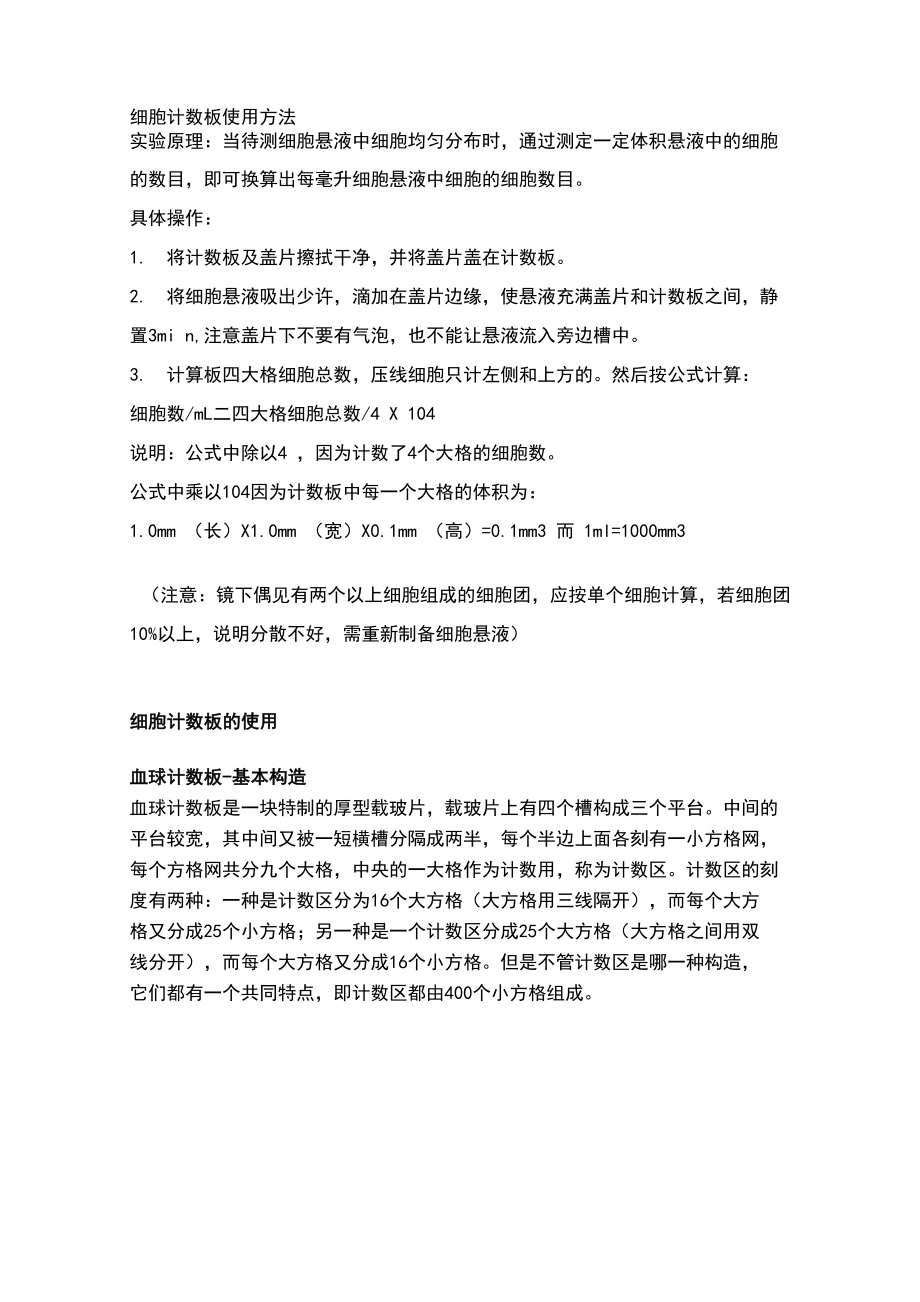 细胞计数板使用方法
细胞计数板使用方法



《细胞计数板使用方法》由会员分享,可在线阅读,更多相关《细胞计数板使用方法(9页珍藏版)》请在装配图网上搜索。
1、细胞计数板使用方法 实验原理:当待测细胞悬液中细胞均匀分布时,通过测定一定体积悬液中的细胞的数目,即可换算出每毫升细胞悬液中细胞的细胞数目。具体操作:1. 将计数板及盖片擦拭干净,并将盖片盖在计数板。2. 将细胞悬液吸出少许,滴加在盖片边缘,使悬液充满盖片和计数板之间,静置3mi n,注意盖片下不要有气泡,也不能让悬液流入旁边槽中。3. 计算板四大格细胞总数,压线细胞只计左侧和上方的。然后按公式计算:细胞数/mL二四大格细胞总数/4 X 104说明:公式中除以4 ,因为计数了4个大格的细胞数。公式中乘以104因为计数板中每一个大格的体积为:1.0mm (长)X1.0mm (宽)X0.1mm (
2、高)=0.1mm3 而 1ml=1000mm3(注意:镜下偶见有两个以上细胞组成的细胞团,应按单个细胞计算,若细胞团10%以上,说明分散不好,需重新制备细胞悬液)细胞计数板的使用血球计数板-基本构造血球计数板是一块特制的厚型载玻片,载玻片上有四个槽构成三个平台。中间的 平台较宽,其中间又被一短横槽分隔成两半,每个半边上面各刻有一小方格网, 每个方格网共分九个大格,中央的一大格作为计数用,称为计数区。计数区的刻 度有两种:一种是计数区分为16个大方格(大方格用三线隔开),而每个大方 格又分成25个小方格;另一种是一个计数区分成25个大方格(大方格之间用双 线分开),而每个大方格又分成16个小方格
3、。但是不管计数区是哪一种构造, 它们都有一个共同特点,即计数区都由400个小方格组成。I t:i nt| 1V| ml J. 计数区边长为1mm,则计数区的面积为1mm2,每个小方格的面积为1/400mm2。盖 上盖玻片后,计数区的高度为0.1mm,所以每个计数区的体积为0.1mm3,每个小 方格的体积为1/4000mrw。使用细胞计数板计数时,先要测定每个小方格中微生物的数量,再换算成每毫升 菌液(或每克样品)中微生物细胞的数量。细胞计数板-使用方法1视待测菌悬液浓度,加无菌水适当稀释(斜面一般稀释100倍),以每小格 的菌数可数为度。2取洁净的细胞计数板一块,在计数区上盖上一块盖玻片。3将
4、菌悬液摇匀,用滴管吸取少许,从计数板中间平台两侧的沟槽内沿盖玻片 的下边缘摘入一小滴(不宜过多),让菌悬液利用液体的表面张力充满计数区, 勿使气泡产生,并用吸水纸吸去沟槽中流出的多余菌悬液。也可以将菌悬液直接 滴加在计数区上(不要使计数区两边平台沾上菌悬液,以免加盖盖玻片后,造成 计数区深度的升高),然后加盖盖玻片(勿使产生气泡)。4静置片刻,使细胞沉降到计数板上,不再随液体漂移。将细胞计数板放置于 显微镜的载物台上夹稳,先在低倍镜下找到计数区后,再转换高倍镜观察并计数。 由于生活细胞的折光率和水的折光率相近,观察时应减弱光照的强度。5.计数时若计数区是由16个大方格组成,按对角线方位,数左上
5、、左下、右上、 右下的4个大方格(即100小格)的菌数。如果是25个大方格组成的计数区, 除数上述四个大方格外,还需数中央1个大方格的菌数(即80个小格)。为了 保证计数的准确性,避免重复计数和漏记,在计数时,对沉降在格线上的细胞的 统计应有统一的规定。如菌体位于大方格的双线上,计数时则数上线不数下线, 数左线不数右线,以减少误差。即位于本格上线和左线上的细胞计入本格,本格 的下线和右线上的细胞按规定计入相应的格中。见下图:即本格中计数细胞为3 个。6对于出芽的酵母菌,芽体达到母细胞大小一半时,即可作为两个菌体计算。 每个样品重复计数2-3次(每次数值不应相差过大,否则应重新操作),按公式 计
6、算出每mL (g)菌悬液所含细胞数量。7测数完毕,取下盖玻片,用水将细胞计数板冲洗干净,切勿用硬物洗刷或抹 擦,以免损坏网格刻度。洗净后自行晾干或用吹风机吹干,放入盒内保存。细胞计数板-计数公式1、16格X25格的细胞计数板计算公式:细胞数/ml=100小格内细胞个数 /100X400X10000X 稀释倍数1、25格X16格的细胞计数板计算公式:细胞数/ml=80小格内细胞个数 /80X400X10000X 稀释倍数血细胞计数板计数的误差主要来自哪些方面应如何尽量减少误差,力求准确血细胞计数的误差分别来源于技术误差和固有误差。其中由于操作人员采血不顺 利,器材处理、使用不当,稀释不准确,细胞
7、识别错误等因素所造成的误差属技 术误差;而由于仪器(计数板、盖片、吸管等)不够准确与精密带来的误差称仪 器误差,由于细胞分布不均匀等因素带来的细胞计数误差属于分布误差或计数域 误差(filed error)。仪器误差和分布误差统称为固有误差或系统误差。技术误 差和仪器误差可通过规范操作、提高熟练程度和校正仪器而避免或纠正,但细胞 分布误差却难于彻底消除。因此,搞好红细胞计数的质量控制一般需采用以下措 施。1避免技术误差,纠正仪器误差(1)所用器材均应清洁干燥,计数板、血盖片、微量吸管及刻度吸管的规格应 符合要求或经过校正。计数板的鉴定:要求计数室的台面光滑、透明,划线清 晰,计数室划线面积准确
8、。必要时采用严格校正的目镜测微计测量计数室的边长 与底面积,用微米千分尺测量计数室的深度。美国国家标准局(NBS )规定每个 大方格边长的误差应小于1%,即10.01mm,深度误差应小于2%,即土0.002mm。若超过上述标准,应弃之不用。血盖片应具有一定的重量,平整、光滑、无裂 痕,厚薄均匀一致,可使用卡尺多点测量(至少在9个点),不均匀度在0.002mm 之内。必要时采用平面平行仪进行测量与评价,要求呈现密集平行的直线干涉条 纹。最简单的评价方法是将洁净的盖片紧贴于干燥的平面玻璃上,若能吸附一定 的时间不脱落,落下时呈弧线形旋转,表示盖片平整、厚薄均匀。同时,合格的 盖片放置在计数室表面后
9、,与支持柱紧密接触的部位可见到彩虹。精选出的盖片 与其他盖片紧密重合后,在掠射光线下观察,如见到完整平行的彩虹条纹表示另 一枚盖片质量也符合要求。目前临床实验室多采用一次性微量采血管采集毛细 血管血,除注意定点购买使用信誉较好厂家的产品外,还应对每一批量的采血管 进行抽样检查,可通过水银称重法或有色溶液比色法进行校正,误差不应超过 1%。(2)红细胞稀释液应等渗、新鲜、无杂质微粒。(3)严格操作,从消毒、采血、稀释、充池到计数都应规范,尤其应注意的是 血样稀释及充池时既要作到充分混匀,又要防止剧烈震荡为破坏红细胞。必须一 次性充满计数室,防止产生气泡,充入细胞悬液的量以不超过计数室台面与血盖
10、片之间的矩形边缘为宜。(4)报告法定计量单位。 2缩小计数域误差或分布误差 由于血细胞在充入计数室后呈随机分布或称 Poisson分布(),而我们所能计数的细胞分布范围是有限的,由此造成的计数 误差称为计数域误差或分布误差。缩小这种误差的有效方法就是尽量扩大细胞计 数范围和计数数目,一般先进行误差估计,然后决定所需计数的数目和计数范围, 只要能将误差控制在允许范围内即可。Berks。n指出,当使用同一支吸管、同一 面计数室,计数0.2mm2面积的细胞数,有望将CV控制在可接受的7%以内。对 于红细胞计数而言,由于红细胞数量较多,在计数室中显得比较“拥挤”,根据 Poisson公式()推断,。欲
11、将误差控制在变异百分数5%以内,至少需要在计 数室中计数400个红细胞,因此要求计数五个中方格的红细胞。事实上Berkson 还通过实验证明,红细胞的计数域误差为s=,较理论误差(Poisson分布误差) 要小。3排除异常标本的干扰 白细胞数量在正常范围时,相对于红细胞数量来讲, 其影响可忽略,但如白细胞过高(100X1094),则应对计数结果进行校正。方 法是:实际RBC二计得RBC-WBC。如当红细胞换算后为X1012/L、白细胞换算后 为100X109/L时,病人实际红细胞数应为X1012/L。在高倍镜下计数时,避 开有核细胞。有核细胞体积比正常红细胞大,中央无凹陷,无草黄色折光,可隐
12、约见到细胞核。此外,当病人急性严重贫血时网织红细胞可提前大量释放,也给 红细胞计数带来一定的干扰,而且影响网织红细胞绝对值计算结果。其校正方法 有待探讨。Using a Counting ChamberFor microbiology, cell culture, and many applications that require use of suspe nsions of cells it is n ecessary to determ ine cell concen trati on. One can often determine cell density of a suspensi
13、on spectrophotometrically, however that form of determ in ati on does not allow an assessment of cell viability, nor can one dist inguish cell types.A device used for determining the number of cells per unit volume of a suspension is called a counting chamber. The most widely used type of chamber is
14、 called a hemocytometer, since it was orig inally designed for performing blood cell counts.To prepare the counting chamber the mirror-like polished surface is carefully cleaned with lens paper. The coverslip is also cleaned. Coverslips for counting chambers are specially made and are thicker than t
15、hose for conventional microscopy, since they must be heavy enough to overcome the surface tension of a drop of liquid. The coverslip is placed over the counting surface prior to putt ing on the cell suspension. The suspension is introduced into one of the V-shaped wells with a pasteur or other type
16、of pipet. The area under the coverslip fills by capillary acti on. Enough liquid should be introduced so that the mirrored surfaceis just covered. The charged counting chamber is then placed on the microscope stage and the countin g grid is brought in to focus at low power.Small square = 1/400 sq. m
17、m. 1/2.5 sq. mm.It is essential to be extremely careful with higher power objectives, since the counting chamber is much thicker tha n a conventional slide. The chamber or an objective lens may be damaged if the user is not not careful. One entire grid on standard hemacytometers with Neubauer ruling
18、s can be seen at 40x (4x objective). The main divisi ons separate the grid into 9 large squares (like a tic-tac-toe grid). Each square has a surface area of one square mm, and the depth of the chamber is 0.1 mm. Thus the entire counting grid lies under a volume of 0.9 mm-cubedSuspensions should be d
19、ilute enough so that the cells or other particles do not overlap each other on the grid, and should be uniformly distributed. To perform the count, determine the magnification needed to recognize the desired cell type. Now systematically count the cells in selected squares so that the total count is
20、 100 cells or so (number of cells needed for a statistically significant count). For large cells this may mean counting the four large cornersquares and the middle one. Fora dense suspension of small cells you may wish to count the cells in the four 1/25 sq. mm corners plus the middle square in the
21、central square. Always decide on a specific counting patter to avoid bias. For cells that overlap a ruling, count a cell as in if it overlaps the top or right ruling, and out if it overlaps the bottom or left ruling.Here is a way to determine a particle count using a Neubauer hemocytometer. Suppose
22、that you conduct a count as described above, and count 187 particles in the five small squares described. Each square has an area of 1/25 mm-squared (that is, 0.04 mm-squared) and depth of 0.1 mm. The total volume in each square is x = 0.004 mm-cubed. You have five squares with combined volume of 5x
23、 = 0.02 mm-cubed. Thus you counted 187 particles in a volume of 0.02 mm-cubed, giving you 187/ = 9350 particles per mm-cubed. There are 1000 cubic millimeters in one cubic centimeter (same as a milliliter), so your particle count is 9,350,000 per ml.Cells are often large enough to require counting o
24、ver a larger surface area. For example, you might count the total number of cells in the four large corner squares plus the middle combined. Each square has surface area of 1 mm-squared and a depth of 0.1 mm, giving it a volume of 0.1 mm-cubed. Suppose that you counted 125 cells (total) in the five
25、squares. You then have 125 cells per 0.5 mm-cubed, which is 250 cells/mm-cubed. Again, multiply by 1000 to determine cell count per ml (250,000).Sometimes you will need to dilute a cell suspension to get the cell density low enough for counting. In that case you will need to multiply your final count by the dilution factor. For example, suppose that for counting you had to dilute a suspension of Chlamydomonas 10 fold. Suppose you obtained a final count of 250,000 cells/ml as described above. Then the count in the original (undiluted) suspension is 10 x 250,000 which is 2,500,000 cells/ml.
- 温馨提示:
1: 本站所有资源如无特殊说明,都需要本地电脑安装OFFICE2007和PDF阅读器。图纸软件为CAD,CAXA,PROE,UG,SolidWorks等.压缩文件请下载最新的WinRAR软件解压。
2: 本站的文档不包含任何第三方提供的附件图纸等,如果需要附件,请联系上传者。文件的所有权益归上传用户所有。
3.本站RAR压缩包中若带图纸,网页内容里面会有图纸预览,若没有图纸预览就没有图纸。
4. 未经权益所有人同意不得将文件中的内容挪作商业或盈利用途。
5. 装配图网仅提供信息存储空间,仅对用户上传内容的表现方式做保护处理,对用户上传分享的文档内容本身不做任何修改或编辑,并不能对任何下载内容负责。
6. 下载文件中如有侵权或不适当内容,请与我们联系,我们立即纠正。
7. 本站不保证下载资源的准确性、安全性和完整性, 同时也不承担用户因使用这些下载资源对自己和他人造成任何形式的伤害或损失。
